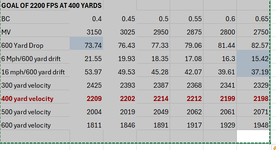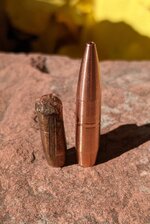DagOtto
Lil-Rokslider
- Joined
- Jun 19, 2024
- Messages
- 157
Follow along with the video below to see how to install our site as a web app on your home screen.
Note: This feature may not be available in some browsers.


If you look at the formulas for drop and drift, weight is nowhere to be found.I am also embarrassed to admit that I had never realized that bullets of completely different calibers with completely different weights will behave identically if their BC's are the same. For example: a 260 grain .338 bullet with a BC of .450 and a 120 grain .243 bullet with the same .450 BC, when fired at the same muzzle velocity, will have the same drop and wind drift at all distances.... weird.
shoo
While not directly in the calculation, weight does show up indirectly in bc when looking at a single caliber. Ie a heavy for caliber has a higher bc so drift and drop are less. Also longer is usually higher bc and higher weight. While it’s not exactly correct that heavier is better, it’s not wrong either. It’s what I like to call redneck engineering. Observing a phenomenon and then explaining in a completely wrong way.If you look at the formulas for drop and drift, weight is nowhere to be found.
You'll see comments all the time about how you need a heavier or larger diameter bullet to "buck the wind", but neither of those are variables in wind drift. All that comment does is tell everyone else they don't understand exterior ballistics.
I think this is an area where our calculators are holding people back in understanding. Just like in school where the teacher made you show your work and not use the calculator so you'd have an actual understanding of what is going on instead of becoming a biological servo for a computer.
Ya, just because sometimes it fits doesn't mean it's correct.While not directly in the calculation, weight does show up indirectly in bc when looking at a single caliber. Ie a heavy for caliber has a higher bc so drift and drop are less. Also longer is usually higher bc and higher weight. While it’s not exactly correct that heavier is better, it’s not wrong either. It’s what I like to call redneck engineering. Observing a phenomenon and then explaining in a completely wrong way.
But comparison between calibers, weight is not really relevant.
I've heard Chris Way and maybe even Frank Galli say this but yet every ballistic calculator seems to disagree on the drift portion of it. Otherwise lightweight, lousy BC bullets driven fast would have less wind drift in short to medium ranges than heavy much higher BC bullets but that is not the case far as I know.The drift and drop equations are all about time of flight.
I believe it’s because wind is really drag related. Thus a lower bc has more drag and the wind has more effect even if time of flight is quicker. Drop is all about time of flight as gravity is the force at work.I've heard Chris Way and maybe even Frank Galli say this but yet every ballistic calculator seems to disagree on the drift portion of it. Otherwise lightweight, lousy BC bullets driven fast would have less wind drift in short to medium ranges than heavy much higher BC bullets but that is not the case far as I know.
That is my understanding as well yet people frequently talk about wind drift being primarily a function of TOF.I believe it’s because wind is really drag related. Thus a lower bc has more drag and the wind has more effect even if time of flight is quicker. Drop is all about time of flight as gravity is the force at work.
Has anyone shot these yet?Hammer has a new HBC bullet they just introduced.
In one of Hornady's Podcasts, Jayden Quinlan noted that the wind drift is tied to "lag time" (the difference between the time it took the bullet to get to target, and the time it would have taken in a vacuum). This is probably what determines the "rate" of drift (i.e. inches per second). TOF would still matter as it's coupled with the rate of drift. Jayden did note that even though one bullet could have a lower rate of drift, if it's taking longer to get to the target it will still likely drift more overall.That is my understanding as well yet people frequently talk about wind drift being primarily a function of TOF.
The calculators suggest this is true. I was looking at my 25 prc with 134’s at 2850 vs a 25-06 with 80g at 3450. The 80g has similar drop but more wind than the 134.I feel like even at 3-400 yards - shoot a 55 vmax or SBK vs a 75 ELDm at hundreds of fps slower. The light bullets will get to the target faster and will get pushed around more by wind.
I misspoke. Wind drift isn't about actual time of flight. It's about lag time. Which is time of flight minus time of flight in a vacuum. This is why BC trumps MV for wind drift. It's 100% about the extra time it takes to get to the target because of the drag of the bullet, times wind.I've heard Chris Way and maybe even Frank Galli say this but yet every ballistic calculator seems to disagree on the drift portion of it. Otherwise lightweight, lousy BC bullets driven fast would have less wind drift in short to medium ranges than heavy much higher BC bullets but that is not the case far as I know.
Did you crimp or just run it?The Hammer HBC is new and offers some good coefficients for copper bullets. Another benefit of the HBC is lower pressure and higher velocity compared to traditional bullets. I was able to do some testing with the 141gr .284 bullet. The rifle was chambered in 280AI and had a 22" barrel. With very little effort I was able to achieve a .29" 3 shot group @ 3280fps. I'm told higher velocity is possible but if that load proves repeatable I'd be very happy.
I did a comparison years ago of a 270 win and 6.5 creedmoor, which illustrated this. Similar weight bullets, the 270 sent worse BC bullets faster than the sleeker 6.5 did slower, but the wind drifts were similar out to 400 yards. Getting there sooner provides less time for the wind to work on the bullet, making up for some BC.I've heard Chris Way and maybe even Frank Galli say this but yet every ballistic calculator seems to disagree on the drift portion of it. Otherwise lightweight, lousy BC bullets driven fast would have less wind drift in short to medium ranges than heavy much higher BC bullets but that is not the case far as I know.
I am developing a load for the Hammer .264 120 gr HBC. A light crimp helped with group size and velocity stats, but I havent yet experimented with different amounts of crimp. I have only tried no crimp vs 1/8 turn crimp on a Lee FCD...but the crimp definitely helped. Crimp also added about ~20 fps.Did you crimp or just run it?
BCs and accuracy are useless if the bullets don't have great terminal performance on game. Hammer bullets have failed me on big elk before and Steve told me that it must have been a ..." bad batch of bar stock..." But they were very accurate with high BCs but QC on the metallurgy and design were flawed, which is why they are likely testing tipped bullets.... which I would never buy because they force you to install yourself and another point of potential failure.Thanks Bluefish and Madcalfe.
Have updated with your additions plus cutting edge extended range.
Those Cayuga's have some bad-ass BCs if they are accurate!
